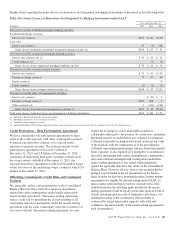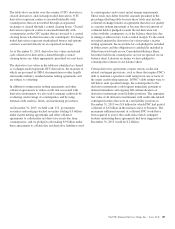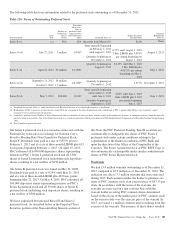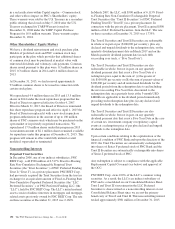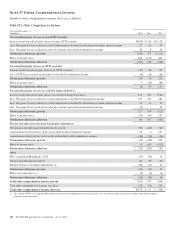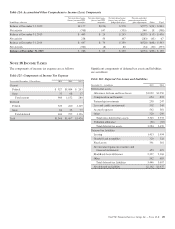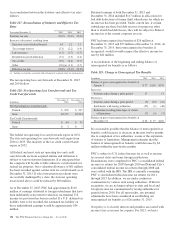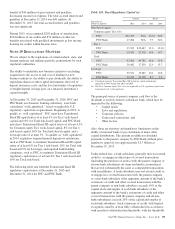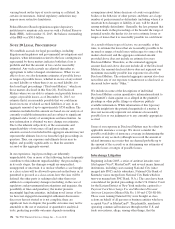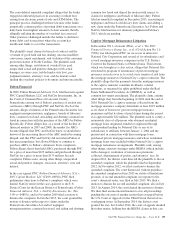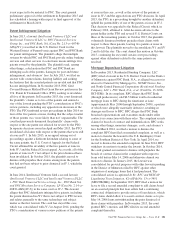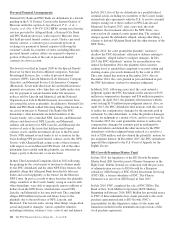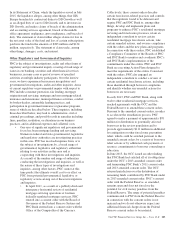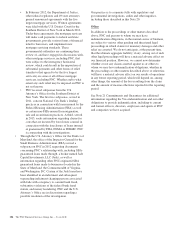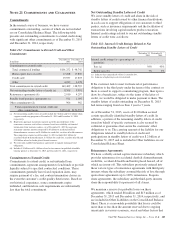PNC Bank 2015 Annual Report Download - page 213
Download and view the complete annual report
Please find page 213 of the 2015 PNC Bank annual report below. You can navigate through the pages in the report by either clicking on the pages listed below, or by using the keyword search tool below to find specific information within the annual report.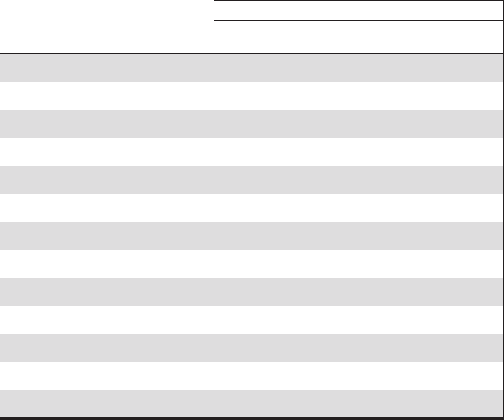
benefit of $46 million of gross interest and penalties,
decreasing income tax expense. The total accrued interest and
penalties at December 31, 2014 was $41 million. At
December 31, 2015, the total accrued interest and penalties
was not significant.
During 2015, we recognized $202 million of amortization,
$224 million of tax credits and $74 million of other tax
benefits associated with qualified investments in low income
housing tax credits within Income taxes.
N
OTE
19 R
EGULATORY
M
ATTERS
We are subject to the regulations of certain federal, state, and
foreign agencies and undergo periodic examinations by such
regulatory authorities.
The ability to undertake new business initiatives (including
acquisitions), the access to and cost of funding for new
business initiatives, the ability to pay dividends, the ability to
repurchase shares or other capital instruments, the level of
deposit insurance costs, and the level and nature of regulatory
oversight depend, in large part, on a financial institution’s
capital strength.
At December 31, 2015 and December 31, 2014, PNC and
PNC Bank, our domestic banking subsidiary, were both
considered “well capitalized,” based on applicable U.S.
regulatory capital ratio requirements. Beginning in 2015, to
qualify as “well capitalized”, PNC must have Transitional
Basel III capital ratios of at least 6% for Tier 1 risk-based
capital and 10% for Total risk-based capital, and PNC Bank
must have Transitional Basel III capital ratios of at least 6.5%
for Common equity Tier 1 risk-based capital, 8% for Tier 1
risk-based capital, 10% for Total risk-based capital, and a
Leverage ratio of at least 5%. To qualify as “well capitalized”
in 2014, regulators required insured depository institutions,
such as PNC Bank, to maintain Transitional Basel III capital
ratios of at least 6% for Tier 1 risk-based, 10% for Total risk-
based and 5% for Leverage, and required bank holding
companies, such as PNC, to maintain Transitional Basel III
regulatory capital ratios of at least 6% Tier 1 risk-based and
10% for Total risk-based.
The following table sets forth the Transitional Basel III
regulatory capital ratios at December 31, 2015 and
December 31, 2014 for PNC and PNC Bank.
Table 130: Basel Regulatory Capital (a)
Amount Ratios
December 31
Dollars in millions 2015 2014 2015 2014
Risk-based capital
Common equity Tier 1 (b)
PNC $31,493 N/A 10.6% N/A
PNC Bank 27,484 N/A 9.7 N/A
Tier 1
PNC 35,522 $35,687 12.0 12.6%
PNC Bank 29,425 29,328 10.4 10.7
Total
PNC 43,260 44,782 14.6 15.8
PNC Bank 36,482 37,559 12.9 13.7
Leverage
PNC 35,522 35,687 10.1 10.8
PNC Bank 29,425 29,328 8.7 9.2
(a) Calculated using the Transitional Basel III regulatory capital methodology
applicable to PNC during both 2015 and 2014.
(b) For 2014, Common equity Tier 1 was not applicable to U.S. regulatory capital ratio
requirements for “well capitalized.”
The principal source of parent company cash flow is the
dividends it receives from its subsidiary bank, which may be
impacted by the following:
• Capital needs,
• Laws and regulations,
• Corporate policies,
• Contractual restrictions, and
• Other factors.
Also, there are statutory and regulatory limitations on the
ability of national banks to pay dividends or make other
capital distributions. The amount available for dividend
payments to the parent company by PNC Bank without prior
regulatory approval was approximately $1.7 billion at
December 31, 2015.
Under federal law, a bank subsidiary generally may not extend
credit to, or engage in other types of covered transactions
(including the purchase of assets) with, the parent company or
its non-bank subsidiaries on terms and under circumstances
that are not substantially the same as comparable transactions
with nonaffiliates. A bank subsidiary may not extend credit to,
or engage in a covered transaction with, the parent company
or a non-bank subsidiary if the aggregate amount of the bank’s
extensions of credit and other covered transactions with the
parent company or non-bank subsidiary exceeds 10% of the
capital stock and surplus of such bank subsidiary or the
aggregate amount of the bank’s extensions of credit and other
covered transactions with the parent company and all non-
bank subsidiaries exceeds 20% of the capital and surplus of
such bank subsidiary. Such extensions of credit, with limited
exceptions, must be at least fully collateralized in accordance
with specified collateralization thresholds, with the thresholds
The PNC Financial Services Group, Inc. – Form 10-K 195


